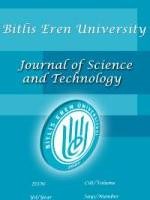Determination of Radon Gas Activity Levels in Drinking Water in Ahlat/Bitlis
Determination of Radon Gas Activity Levels in Drinking Water in Ahlat/Bitlis
Radon gas, Ahlat stone, Drinking water,
___
- Duggal V., Sharma S., Mehra R., 2017. Radon levels in drinking water of Fatehabad district of Haryana, India. Applied Radiation and Isotopes, 123, 36-40.
- Meisenberg O., Mishra R., Joshi M., Gierl S., Rout R., Guoa L., Agarwal T., Kanse S., Irlinger J., Sapra B.K., Tschiersch J., 2017. Radon and thoron inhalation doses in dwellings with earthen architecture: Comparison of measurement methods. Science of the Total Environment. 579, 1855–1862.
- Mittal S., Rani A., Mehra R., 2016. Radon levels in drinking water and soil samples of Jodhpur and Nagaur districts of Rajasthan, India. Applied Radiation and Isotopes. 113, 53-59.
- Nikolopoulos D., Louizi A., 2008. Study of indoor radon and radon in drinkingwater in Greece and Cyprus: Implications to exposure and dose. Radiation Measurements. 43, 1305-1314.
- Nikolopoulos D., Vogiannis E., Petraki E., Zisos A., Louizi A., 2010. Investigation of the exposure to radon and progeny in the thermal spas of Loutraki (Attica-Greece): Results from measurements and modelling. Science of the Total Environment. 408, 495–504.
- Schubert M., Buerkin W., Pena P., Lopez A.E., Balcazar M., 2006. On-site determination of the radon concentration in water samples: Methodical background and results from laboratory studies and a field-scale test. Radiation Measurements. 41, 492-497.
- Singh, J.,Singh,H.,Singh,S.,Bajwa,B.S.,2008. Estimation of uranium and radon concentration in some drinking water samples. Radiat.Meas. 43,S523–S526.
- UNSCEAR (United Nations Scientific Committee on the Effects of Atomic Radiations), 2000. Sources, effects and risks of ionizing radiation. United Nations, New York.
- UNSCEAR (United Nations Scientific Committee on the Effects of Atomic Radiations), 2008. Report to General Assembly with Scientific annexes. United Nations Sales Publications. United Nations, New York.
- USEPA (United States Environmental Protection Agency), 1991. Federal Register 40 Parts 141 and 142: national Primary Drinking Water Regulations; Radionuclides: proposed Rule. U.S. Government Printing Office.
- WHO (World Health Organisation), 2014. World Cancer Report. ISBN (PDF) 978-92-832-0443-5.
- WHO (World Health Organisation), 2014. Guidelines for Drinking Water Quality, Fourth Edition Incorporating The First Addendum. ISBN 978-92-4-154995-0.
- Yayın Aralığı: Yılda 2 Sayı
- Başlangıç: 2011
- Yayıncı: Bitlis Eren Üniversitesi
Application of wireless power system automation for electrical distribution system of Van, Turkey
Sabir RÜSTEMLİ, Abdulkadir ÖZER, Mehmet Nuri ALMALI, Mustafa AKDAĞ
Construction of an Economic Blanket Belt Oil Skimmer
Sumon KHANDAKAR, Md. Nasiqul ISLAM, Robiul İslam RUBEL, Sk. Suzauddin YUSUF
Determination of fracture toughness parameters of concrete using compact pressure test
Composition of the essential oils of two Teucrium species from Turkey
Şükrü HAYTA, Ayşe YAZGIN, Eyup BAĞCI
Mammal Fauna of Ihlara Valley (Aksaray, Turkey)
Kubilay TOYRAN, Tarkan YORULMAZ, Serdar GÖZÜTOK
Effect of Relay-Priority Mechanism on Multi-hop Wireless Sensor Networks
Davut ARI, Musa ÇIBUK, Fikri AĞGÜN
Determining of Apoptosis at in vitro Conditioned DRG Neurons with TUNEL Method
Determination of Radon Gas Activity Levels in Drinking Water in Ahlat/Bitlis
Muhammed Fatih KULUÖZTÜRK, Aydın BÜYÜKSARAÇ, Fahrettin ÖZBEY, Sezai YALÇIN
Investigation of Strength Characteristics of Natural Stones in Ürgüp (Nevşehir/Turkey)
